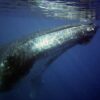Drive hunting is a brutal practice where dolphins and small whales are herded into shallow bays or onto beaches using boats and loud noises. Once trapped, their escape is blocked with nets, leaving them at the mercy of hunters. In some countries, these animals are slaughtered for meat; in others, they are captured alive and sold to marine parks and aquariums around the world.
Despite international outrage, drive hunts still take place today.
Faroe Islands – The Grindadráp: Tradition or Cruelty?
Every year in the Faroe Islands, an autonomous territory of the Kingdom of Denmark, entire pods of pilot whales and dolphins are driven into shallow bays and brutally slaughtered in a practice known as the Grindadráp. Despite being defended as a cultural tradition, the hunts cause immense suffering and have no place in the modern world.
The first grind of 2025 occurred on January 10th in Árnafjarðarvík, where 47 pilot whales were slaughtered, among them pregnant females and young calves. In June, another 246 whales were killed in Leynar, including at least 30 pregnant females — their unborn calves discarded as waste. Then, in July, two separate hunts took place just hours apart in Suðuroy and Bøur, claiming the lives of 95 whales. Among the dead were juveniles and four pregnant females, one of whom was in the process of giving birth as the pod was driven ashore and killed. In September, at least 270 pilot whales were butchered – this isn’t tradition — it’s a massacre, and it seems no one can stop these individuals who are determined to keep this tradition going. The brutality of these events is nothing short of horrific.
The brutality and suffering caused by these hunts are deeply shocking. Yet, tourism and government officials in the Faroe Islands continue to defend them as an important ancestral tradition. How long will these brutal killings be allowed to continue? Culture should never be used as a shield to justify cruelty.
Japan – Taiji Dolphin and Small Whale Hunt: A Harsh Reality
Every year, in the quiet coastal town of Taiji, Japan, nearly 2,000 dolphins and small whales face a terrifying ordeal. From September to March, local fishermen use motorboats and relentless noise—banging metal poles underwater—to create a wall of sound that herds these intelligent, social creatures away from the open sea and into a shallow, netted cove. Trapped and confused, families of dolphins are torn apart. Many are brutally slaughtered for their meat, a practice that has sparked global outrage. Others, including vulnerable mothers and calves, are sold alive to marine parks and aquariums, where they are removed from everything they know and loved—condemned to a life in captivity. Calves are separated from their mothers, and many dolphins that aren’t selected for captivity are pushed back into the ocean, but their chances of survival are slim. This annual hunt not only causes immense suffering but also raises urgent questions about animal welfare, conservation, and humanity’s responsibility to protect these remarkable creatures.
For the 2024/25 season (September to February), a total quota of 1,824 cetaceans was set. Despite growing international condemnation, an estimated 301 cetaceans were slaughtered for their meat, including 23 short-finned pilot whales, 31 bottlenose dolphins, and 48 Risso’s dolphins. Additionally, up to 99 dolphins were captured for the captivity industry—94 bottlenose dolphins, three striped dolphins, and two Risso’s dolphins. Tragically, many young calves were separated from their mothers and released back into the sea, far too young to survive on their own. Looking ahead, the quota for the 2025/26 season remains nearly unchanged at 1,814 cetaceans.
Despite widespread criticism, the Taiji Government continues to defend these hunts as a centuries-old tradition—claiming they are integral to the town’s heritage and economy. Local fishermen remain adamant that they will not end the hunts, insisting that they are vital to their livelihoods. The urgent question remains: how much longer will Taiji profit from the suffering and exploitation of these intelligent, sentient creatures?



